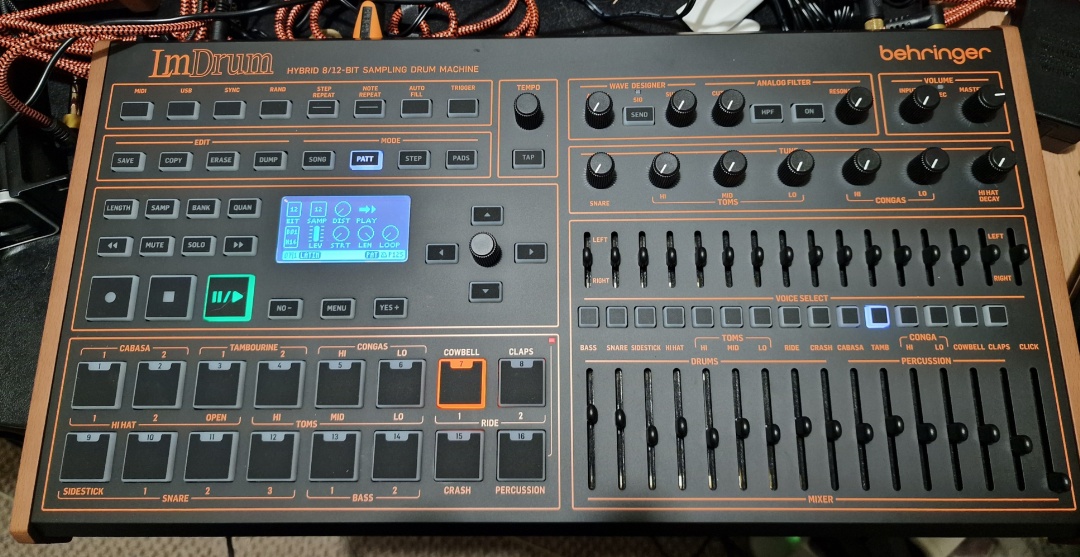Behringer LM Drum review

Something I'd been looking forward to trying for months is the Behringer LM Drum.
Born in the 70's and becoming obsessed with music through the early 80's, I grew up with the sounds of the LinnDrum and Oberheim DMX long before the Roland X0X machines became the staple for House and Techno. Planet Rock had the 808 but the LinnDrum was everywhere!
Like many others, as soon as Behringer put videos on YouTube about rescuing the LinnDrum used by Tears For Fears, I suspected that a clone would be forthcoming. We just had to wait a long time for it to finally arrive — a December 2024 launch with shipping early 2025.
The basics
The LM Drum is Behringer's clone/reimagining of the famous LinnDrum from the early 80's. But so much more. Where their other drum machines emulate a single device, the LM Drum contains 6 kits by default and is also a sampler.
The kits included are:
- LM1
- LinnDrum (listed as LM2)
- LM9000
- Sequential DrumTraks
- Simmons SDS
- TMC, possibly The Movement (Systems Percussion) Computer
Samples can be recorded and edited directly on the device via an audio input or copied over using Behringer's SynthTribe app.
Samples can be arranged into custom kits (referred to as Banks) via the app or by menu diving on the machine itself. Using the app is quicker if creating full kits from scratch, but it is simple and quick enough to replace individual sounds on device.
Total sample time available is 310 seconds, and any sample up to 1MB can be added via the SynthTribe app.
In a step down from the likes of the RD-9, the LM Drum can hold 8 songs with 16 patterns per song (as opposed to 16 & 16) but everything can be imported/exported as needed.
In addition to the stereo outputs — you can just use the left for mono — you have 16 individual outs for the different sounds. There are also three fully assignable trigger outs to control external gear.
First impressions
The LM Drum looks and feels great! It has a perfect 80's aesthetic that resembles the original but retains much of the Behringer-specific workflows from the RD-8 & RD-9, albeit with a different layout.
Build quality is typically solid, with just a slight wobble on a few knobs. The knobs have plastic spindles but don't feel in any danger of breaking. The pads feel better and more responsive than the 'Tap' buttons on the RDs. It's a lot easier to finger drum in time, and that's before the built-in quantisation feature, which I've not felt the need to investigate.
The panning faders have a satisfying dull click when you reach the centre. The knobs feel sturdy enough, and the controls are fairly intuitive, except for a few cases which I'll go into later. The Tap button acts like a shift or function on other devices.
It makes a nice change to have a decent LCD screen, even if it does look for all the world like one from an Elektron.
Out of the box, the LM Drum copies the Linn by only providing tuning for the snare, toms, and congas. Following a comment by Roger Linn himself that this was a mistake, Behringer released a firmware update that enabled tuning for all sounds. So, after an initial listen to some of the default patterns, I hooked the unit up to SynthTribe to do an update.
The update failed leaving me stuck in DFU mode.
Apparently, this is a common thing on Mac. The review almost stopped before it had even started which left a bit of a bad taste. The official workaround is "update it on a Windows PC" but, as this is a known issue, Behringer should really have it fixed by now.
Not a good first impression.
Usage
As is so often the case, I watched a number of review videos since launch so already knew about some of the functionality. Being familiar with Behringer's other drum machines, some of the more basic features were both familiar and/or intuitive.
A common criticism, however, is that the LM Drum only comes with a "quick start" guide — which tells you what everything is but not how to use it. That is reserved for the online manual, which you are advised to find on their website. This aside, it's easy to get up and running with the basics — especially if you are familiar with their other machines.
Programming the machine is based around song, pattern & step selectors, like the RD-8 & 9, but also a pad mode. Each song can contain up to 16 patterns which can be chained to create a full track.
Creating a pattern in step mode is just like any other drum machine: select the required sound and place it where you like within the (up to) 64-step sequence. Where the LM Drum really comes into its own, however, is with the two different pad modes. By default, pad mode allows you to finger drum with each pad playing its assigned sound.
As this is also a sampler, pressing Tap & Pads puts it into chromatic mode where the pads light up to become a faux piano keyboard. Using the Tap button in conjunction with the up & down navigation buttons allows you to move between octaves with a total three-octave range. This grants extra flexibility for tweaking sounds without having to edit the sample directly.
Speaking of samples, once loaded onto the device they can be organised in banks (read kits). The default kits can't be changed, but you have plenty of options to create your own. This can be done through the SynthTribe app by dragging samples into the correct positions or on-device using the options on the LCD screen.
It's here that I have a minor complaint.
Beneath the LCD screen are Menu, Yes & No buttons. Menu is obvious; you'd think the same would be said of Yes & No. One function is, indeed, to confirm or cancel a change. However, they can also be used to go up and down the menu structure: yes to select a sub-menu, no to return to the previous level.
Fair enough. Until you get to editing the sample banks.
Here, you scroll to the required position, then instead of pressing Yes to access the menu, press the "right" button on the directional controls. Why not keep it consistent?
There are also times when I hit the menu button when I should be pressing the central knob in the directional controls, but that's probably just me still getting used to it having not really read the manual.
One other peculiarity, at least coming from the RDs, is that when using the individual outputs those sounds are not excluded from the master out. You have to turn down their volume slider all the way to exclude them manually. The individual outs consequently have fixed volumes so all control must be done in the mixer or DAW.
I have also noticed that the individual outs sound different from the main output. This is likely due to how the main outputs combine and process the mixed signal. It takes some getting used to and can be a little jarring.
Pick one and stick with it.
Conclusion
Minor quibbles aside, the LM Drum is great fun to use, not just for the hardware, but the additional flexibility it allows in my setup.
While it would be very nice to own a 505, 707, etc., being able to use drum samples in an actual machine rather than the DAW really speaks to me.
When I have more time I intend to use the LM Drum to sample the Syncussion and build some weird kits, lots of strange bloops and clangs.
I can highly recommend the LM Drum, not just for the nostalgic look and sound, but for everything else it enables.
